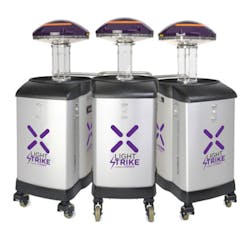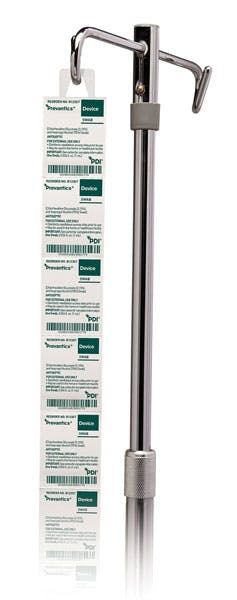A recent HAI Data Report, “Healthcare-associated Infections in the United States, 2006-2016: A Story of Progress,” indicates that rates of hospital-onset Clostridium difficile infection are slow to drop. From a baseline of 1.0 Standardized Infection Ratio (SIR) from 2010-2011, the SIR only dropped to .85 by 2016. The report states, “The most recent pace of progress (i.e. 8% from 2015 to 2016) needs to remain steady or increase to meet national prevention goals for hospital-onset CDI in 2020.”
Reduction in rates of some other hospital-acquired infections are being met with greater success. The report states, “After some early lack of progress, there have been steady declines in [catheter-associated urinary tract infections] CAUTIs over the past few years. The gains have been most marked in non-ICU locations, but recent years have seen progress in ICUs as well. Although CAUTIs that include those caused by yeast declined on wards from 2012 through 2014, they failed to decline in ICUs, where they increased and then remained elevated from 2012 through 2014. However, using the more clinically-relevant CAUTI definition that no longer includes yeast, and applying this retrospectively as well as in the new baseline, there have been consistent year-to-year declines in CAUTIs in both ICUs and wards from 2012 through 2016.”
The report also bears good news on the CLABSI front. “Hospitals have made significant progress in preventing CLABSIs–nationally, there has been a roughly 50% drop in CLABSIs between 2008 and 2016.”
As you explore avenues in reducing infection at your hospital, the experiences of some of those who already have successfully reduced infection in their medical facilities may offer insight and inspiration in how to attack hospital-acquired infections.
Challenging C. diff
Norman Regional Health System
South Central OK
The Norman Regional Health System is a multi-campus system serving patients throughout south central Oklahoma. Its acute-care facility, the 219-bed Norman Regional Hospital, offers a full range of services. The 168-bed HealthPlex campus features cardiovascular services, spine and orthopedic surgery, and women’s and children’s services.
Normal Regional’s infection rates were already low. The combined rate of infection for Clostridium difficile (C. diff), methicillin-resistant Staphylococcus aureus (MRSA), and vancomycin-resistant enterococci (VRE) was 14.43 per 10,000 patient-days or 31 cases. The motivation to improve at Normal Regional, according to Clyde Brawner, Director, Distribution/Transportation and Environmental Services, is, “We believe that one infection is too many.”
What they did: In 2016, the hospital partnered with Xenex to deploy four LightStrike Germ-Zapping Robots. “In an innovative shared-risk agreement, Xenex guaranteed Norman Regional leadership that patient infection rates on evaluation units would decrease or they would refund the money the system invested in the robots,” explained Brawner.
The LightStrike robots’ germicidal UV light kills bacteria and viruses in just minutes, disinfecting high-touch areas and surfaces including bedrails, tray tables, machines, monitors, keyboards, and computers. It can be used in any department and in any unit within a healthcare facility. “Our Environmental Services (EVS), Infection Prevention, Surgery, and Cath Lab departments formed a team and worked closely together to identify units within the hospital on which to focus robot utilization,” said Brawner. “We selected hospital EVS techs, surgical techs, and cath-lab RNs to be trained as Xenex super-user representatives. These individuals trained users to run the robots in selected areas. Fourteen Norman Regional Health System employees are super users, and 20 are users. The Xenex team did a great job of training our team members how to run the robots, and they worked closely with the team to track utilization.”
Results: At the end of one year, the C. diff, MRSA, and VRE infection rates dropped by 36 percent, resulting in a $250,000 savings for the hospital, including the cost of robots and labor to operate them.
Toledo, OH
Mercy Health St. Anne Hospital, a 100-bed community hospital in Toledo, Ohio, is part of the Mercy Health system, the largest health system in Ohio, serving Ohio and Kentucky. Lisa A. Beauch BSN, RN, CAPA, CPAN, CIC, Infection Prevention Regional Manager – Toledo/Lima, stated, “We want all hospital-acquired infections to be eliminated but chose to focus on C. diff infections because it was the one infection that was higher than our predicted number. We were 40 percent above predicted.”
What they did: Mercy Health’s campaign to reduce C. diff began in the fall 2015 and continues to this day. Beauch explained the steps toward improved numbers began with getting administration and departments to be involved on board. “The project’s key departments were administration, EVS, pharmacy, lab, nursing, and infection prevention/quality staff. With administrative support, we began an antimicrobial stewardship program, standardized cleaning processes, educated on proper testing and specimen collection, audited compliance with policy, and heightened awareness. We began using the Clorox Optimum-UV light in December 2015. We implemented a ‘days-since-last-infection’ announcement on our daily safety call to keep up awareness.”
Results: “We went 341 days without a hospital-acquired C. diff and ended 2017 at 70 percent below predicted,” said Beauch.
Utica, NY
Faxton St. Luke’s Healthcare is a 160-bed acute-care facility, an affiliate of Mohawk Valley Health System in Central New York, serving a variety of patient populations including oncology, dialysis, pediatric, maternal child health, and immunocompromised.
What they did: “Our facility had an unacceptably high rate of hospital-onset C. diff infection,” explained Heather L. Bernard, DNP, RN, CIC, FAPIC, Director of Infection Prevention, Mohawk Valley Health System, St. Elizabeth Medical Center. The rate of infection was 19.09 infections per 10,000 patient-days, prior to the interventions.
The campaign began in 2013 and is ongoing. “Prior to 2013, Faxton St. Luke’s began a C. diff-reduction campaign consisting of proper contact precautions during and after treatment, a hand-hygiene program, use of bleach for terminal and daily cleaning of all C. diff rooms, and heightened awareness of the issue,” said Bernard. “Despite best practices in place for reducing C. diff, the rate remained stagnant.”
In June 2013, the Surfacide automated multiple emitter UV-C disinfection system was added to their bundle of interventions. Along with increased attention to prevention efforts, they began to see a reduction in C. diff rates. “The Surfacide Helios system was integral in our ultimate reduction in C. diff infections,” stated Bernard. “Other interventions were simply unable to result in a reduction in our infection rate, but the addition of the Surfacide Helios system resulted in a 41 percent reduction in rates in the first year alone.”
Departments working together to implement this campaign against C. diff included leadership, infection prevention, nursing, the transfer center, and EVS. The administration and nursing departments were initially concerned about interruption in bed flow, so “it was important to demonstrate that the time to perform the UV disinfection would not impact the bed flow by a tremendous amount and that the benefits outweighed the risks,” said Bernard. “Communication between infection prevention and EVS, and proper deployment of the UV disinfection system were key.”
Results: The C. diff infection rate at the end of the study was just under 10 per 10,000 patient-days. “The rates have remained at, or below, that level, with our bundle of best-practice interventions and continued use of the Helios UV disinfection system,” said Bernard. “Our rate at the end of 2017 was 8.5 infections per 10,000 patient-days.”
Elmhurst, IL
Elmhurst Hospital is a community-based acute-care hospital licensed for 259 private patient rooms. Elmhurst Hospital is nationally recognized for its heart failure program, state-of-the-art cancer center, emergency services, technologically advanced surgical services, and level 2E nursery with all private rooms.
What they did: “Elmhurst Hospital’s SIR for hospital-onset C. diff was 1.346 in 2015,” said Annemarie Schmocker, RN, BSN, CIC. “Reducing the hospital-onset C. diff infections became a top priority for the board, senior leadership, and part of the value-based healthcare initiative. Elmhurst Hospital implemented a comprehensive plan of action end of year 2015 into 2016.
“Elmhurst Hospital Senior Leadership fully supported investing in a high-level disinfection (HLD) system for patient rooms,” continued Schmocker. “From the beginning, Elmhurst Hospital included all key players when researching the HLD system to purchase, demo, and implement. Employee feedback was considered throughout the review of HLD systems currently on the market. A comparison analysis of systems (hydrogen peroxide technology versus UV technology) was completed by both housekeeping and infection control. The teamwork and communication that occurred throughout this tedious review prevented any concerns on how this process would be implemented throughout the hospital.” Elmhurst Hospital began using the Altapure High Level Disinfection System in March 2016.
They also built and initiated a protocol within their electronic medical record (EMR) promoting antimicrobial stewardship and diagnostic stewardship, (i.e., timely and appropriate testing for C. diff.) “Lastly,” said Schmocker, “the infection preventionists implemented an active case-management plan for patients with an order placed for C. diff testing.”
“The Altapure High Level Disinfection System has been an outstanding addition in mitigating the risk of environmental contamination of patient rooms,” maintained Schmocker. “A daily communication is sent by Infection Control via email of all patient rooms requiring Altapure HLD.” The patient rooms are marked to receive Altapure with a blue ‘A’ icon within the bed-tracking system built within the EMR.
Results: “Beginning in July 2016, we lowered our SIR to less than one and have sustained it for over 1 ½ years now,” said Schmocker. “Our lowest SIR has been 0.452; our highest, 0.998. We continue to strive for zero hospital-onset infections.”
Conquering CAUTI and CLABSI
Towson, MD
University of Maryland St. Joseph Medical Center is a 224-bed, nonprofit, regional medical center and a member of the University of Maryland Medical System. Major service lines include a comprehensive cancer center, cardiac surgery, orthopedic surgery, and maternal child health services.
What they did: Lisa Hargett, MPH, CIC, Infection Prevention Director, and Theresa Anderson, MS, RN, CIC, Senior Infection Prevention Coordinator, related the story of their successful campaign to reduce catheter-associated urinary tract infections (CAUTIs). “CAUTI reduction progress has been made through standardization and implementation of evidence-based practices,” said Hargett and Anderson. “Despite continuous efforts to reduce infections, the medical-surgical intensive care unit (MSICU) had opportunities for improvement,” noting the MSICU had 9 CAUTIs in fiscal year (FY) 2015, with SIR of 1.79.
“In November 2015, a new process for managing bowel incontinence and enhancing perineal and urinary-catheter care was implemented,” explained Hargett and Anderson. “The interventions included baby wipes for incontinence care and Theraworx (Avadim Technologies) for perineal and urinary-catheter care. Theraworx is designed to be applied to prevent contamination and to create a ‘zone of inhibition.’” This product is used during pre- and post-insertion of urinary catheter, with catheterized patients, for bowel incontinence episodes, during the daily chlorhexidine gluconate bath, and prior to straight catheterization. They increased care from once to up to six times per day, based on the duration of the catheter.
Front line staff were involved in the solution and implementation process, they explained. Departments involved included the MSICU, clinical excellence, infection prevention, and quality improvement.
Results: Theraworx use was started November 2015. “A significant reduction was achieved after implementing enhanced perineal and urinary-catheter care. After implementation, the MSICU celebrated 351 days without a CAUTI. In FY16, there were five CAUTIs (SIR 1.85). In FY17, there were three CAUTIs (SIR 1.30). The success continues, as the unit recently celebrated 365 days CAUTI-free,” stated Hargett and Anderson.
“Rates have progressively decreased since the implementation of the CAUTI bundle. It is important to acknowledge the success is not the result of one single intervention, but multiple interventions designed to reduce CAUTIs.”
St. Louis, MO
St. Louis Children’s Hospital is a full-service Magnet hospital with 280 beds, including a level-I trauma center and level-III neonatal intensive care unit.
What they did: Jennifer Hoermann, BSN, RN, VA-BC, Supervisor, Vascular Access Department, explained their goal. “In 2014, we began to focus heavily on reducing hospital-acquired infections (HAIs). While the focus was on all HAIs, there was a particular goal to reduce central-line–associated bloodstream infections (CLABSIs). CLABSIs have a high mortality rate and are expensive to treat, so we made them a priority.
“We formed a house-wide CLABSI Reduction Committee to concentrate on our high-risk patient populations,” continued Hoermann. “It was, and still is, a multi-disciplinary team with representation from all inpatient units, as well as the infection-prevention team, the unit medical directors, and nursing management.
“A nurse from the high-risk Pediatric Intensive Care Unit (PICU) was on the committee and suggested a trial of 3.15 percent chlorhexidine/70 percent isopropyl alcohol swabs (Prevantics Swab by PDI), to scrub the hubs of central lines, instead of using 70 percent isopropyl alcohol swabs alone. The committee agreed to a trial in the PICU. In mid-2014, the PICU staff was educated on a 15-second scrub and 15-second dry at the start of the trial. All plain alcohol swabs were removed from the nursing supply. The trial lasted 6 months.”
Results: “When the trial began, the PICU had experienced 12 CLABSIs in the previous 12 months, a rate of 2.8 infections per 1,000 line-days. At the conclusion of the trial, there was only one reported CLABSI for a rate of 0.48 infections per 1,000 line-days,” reported Hoermann. “This was an 83 percent decrease in the CLABSI rate. The committee determined house-wide implementation of Prevantics was a must.
Since we implemented Prevantics Swab, we have been able to maintain lower-than-expected CLABSI rates. With the change in how CLABSIs are reported (from a line-day rate to the SIR, it’s difficult to do a year-over-year comparison. However, I’m happy to report the PICU had a 2017 year-end SIR of 0.35. Currently, all units are using Prevantics Swab for scrubbing the hub and for skin prep prior to IV starts.”
Complying with hand hygiene
Blackfoot, ID
Bingham Memorial Hospital is a state-of-the art, non-profit, critical-access hospital, providing more than 100 types of patient services, including inpatient, outpatient, critical care, emergency, rehabilitation, same-day surgery, and transitional care.
What they did: According to Maryann Smout, RN, BSN, Manager of Employee Health/Infection Control, “Bingham earned a reputation as a trusted healthcare provider throughout Eastern Idaho. Close attention is paid to patient-satisfaction scores. Listening to patients’ feedback constantly improves every aspect of services and facilities.”
One area of improvement that Bingham discovered needed to be addressed was how their patients perceived the staff’s attention to hand hygiene. “Consistent hand hygiene is key to reducing healthcare-associated infections, and assessing compliance with hand-hygiene protocols is vital for hospital infection-control staff,” observed Smout.
“Bingham wanted patients to have a way of knowing whether a staff member washed or sanitized his or her hands,” said Smout. “Therefore, the following three key changes were implemented in November 2016.” (1) Hand-sanitizer machines were installed in every patient room within clear view of the patient’s bed, so they could see and hear the machine being used. Previously, hand-sanitizer machines were placed outside patient rooms. (2) BioVigil’s hand-hygiene solution was introduced to hospital protocol. Included in this solution is a badge clipped to a uniform or lab coat worn by hospital staff. It has a green light indicating hands have been washed and sanitized, and a red light indicating that a staff member’s hands have not been washed or sanitized. Upon admission, each patient is educated about the BioVigil badge, drawing their attention to it throughout their stay. (3) A patient-care coordinator visits every patient’s room several times a day to assure all their needs are being met, as well as to reinforce their patients’ understanding of BioVigil’s hand-hygiene solution.
Results: “Before Bingham Memorial implemented these three key changes, including addition of the BioVigil system, hand-hygiene compliance fluctuated between 55 and 70 percent,” said Smout. “Additionally, Bingham Memorial wanted to improve patient satisfaction and engagement ratings, which were consistently in the 37th percentile for hand hygiene by hospital staff. Since the three changes were implemented, Bingham rose to the 90th percentile in overall hand-hygiene compliance and patient satisfaction.”
About the Author

Susan Cantrell
Susan Cantrell is Infection Prevention Editor for Healthcare Purchasing News.







